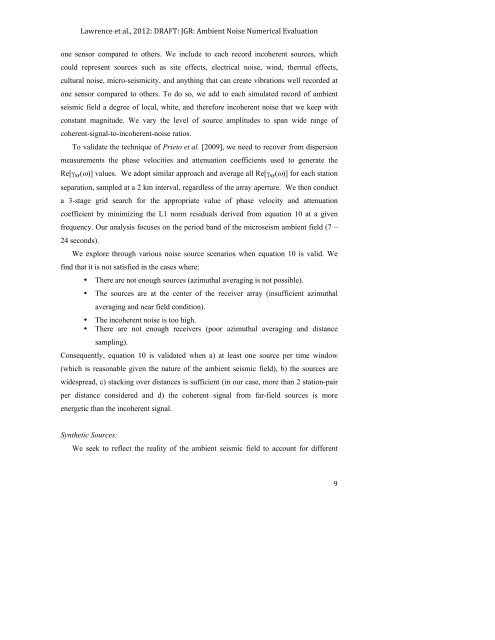Lawrence et al., 2012: DRAFT: JGR: Ambient Noise Numerical ...
Lawrence et al., 2012: DRAFT: JGR: Ambient Noise Numerical ...
Lawrence et al., 2012: DRAFT: JGR: Ambient Noise Numerical ...
Create successful ePaper yourself
Turn your PDF publications into a flip-book with our unique Google optimized e-Paper software.
<strong>Lawrence</strong> <strong>et</strong> <strong>al</strong>., <strong>2012</strong>: <strong>DRAFT</strong>: <strong>JGR</strong>: <strong>Ambient</strong> <strong>Noise</strong> Numeric<strong>al</strong> Ev<strong>al</strong>uation<br />
one sensor compared to others. We include to each record incoherent sources, which<br />
could represent sources such as site effects, electric<strong>al</strong> noise, wind, therm<strong>al</strong> effects,<br />
cultur<strong>al</strong> noise, micro-seismicity, and anything that can create vibrations well recorded at<br />
one sensor compared to others. To do so, we add to each simulated record of ambient<br />
seismic field a degree of loc<strong>al</strong>, white, and therefore incoherent noise that we keep with<br />
constant magnitude. We vary the level of source amplitudes to span wide range of<br />
coherent-sign<strong>al</strong>-to-incoherent-noise ratios.<br />
To v<strong>al</strong>idate the technique of Pri<strong>et</strong>o <strong>et</strong> <strong>al</strong>. [2009], we need to recover from dispersion<br />
measurements the phase velocities and attenuation coefficients used to generate the<br />
Re[γxy(ω)] v<strong>al</strong>ues. We adopt similar approach and average <strong>al</strong>l Re[γxy(ω)] for each station<br />
separation, sampled at a 2 km interv<strong>al</strong>, regardless of the array aperture. We then conduct<br />
a 3-stage grid search for the appropriate v<strong>al</strong>ue of phase velocity and attenuation<br />
coefficient by minimizing the L1 norm residu<strong>al</strong>s derived from equation 10 at a given<br />
frequency. Our an<strong>al</strong>ysis focuses on the period band of the microseism ambient field (7 –<br />
24 seconds).<br />
We explore through various noise source scenarios when equation 10 is v<strong>al</strong>id. We<br />
find that it is not satisfied in the cases where:<br />
• There are not enough sources (azimuth<strong>al</strong> averaging is not possible).<br />
• The sources are at the center of the receiver array (insufficient azimuth<strong>al</strong><br />
averaging and near field condition).<br />
• The incoherent noise is too high.<br />
• There are not enough receivers (poor azimuth<strong>al</strong> averaging and distance<br />
sampling).<br />
Consequently, equation 10 is v<strong>al</strong>idated when a) at least one source per time window<br />
(which is reasonable given the nature of the ambient seismic field), b) the sources are<br />
widespread, c) stacking over distances is sufficient (in our case, more than 2 station-pair<br />
per distance considered and d) the coherent sign<strong>al</strong> from far-field sources is more<br />
energ<strong>et</strong>ic than the incoherent sign<strong>al</strong>.<br />
Synth<strong>et</strong>ic Sources:<br />
We seek to reflect the re<strong>al</strong>ity of the ambient seismic field to account for different<br />
9
















